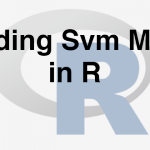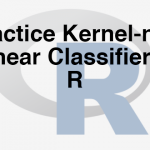
The Non-Linear Decision Boundary
In previous section, we studied about Building SVM model in R
- In the above examples we can clearly see the decision boundary is linear
- SVM works well when the data points are linearly separable
- If the decision boundary is non-liner then SVM may struggle to classify
- Observe the below examples, the classes are not linearly separable
- SVM has no direct theory to set the non-liner decision boundary models.
Mapping to Higher Dimensional Space
- The original maximum-margin hyperplane algorithm proposed by Vapnik in 1963 constructed a linear classifier.
- To fit a non liner boundary classier, we can create new variables(dimensions) in the data and see whether the decision boundary is linear.
- In 1992, Bernhard E. Boser, Isabelle M. Guyon and Vladimir N. Vapnik suggested a way to create nonlinear classifiers by applying the kernel trick
- In the below example, A single linear classifier is not sufficient
- Lets create a new variable \(x2=(x1)^2\). In the higher dimensional space
- We can clearly see a possibility of single linear decision boundary
- This is called kernel trick
Kernel Trick
- We used a function f(x)=(x,\(x^2\)) to transform the data x into a higher dimensional space.
- In the higher dimensional space, we could easily fit a liner decision boundary.
- This function f(x) is known as kernel function and this process is known as kernel trick in SVM
- Kernel trick solves the non-linear decision boundary problem much like the hidden layers in neural networks.
- Kernel trick is simply increasing the number of dimensions. It is to make the non-linear decision boundary in lower dimensional space as a linear decision boundary, in higher dimensional space.
- In simple words, Kernel trick makes the non-linear decision boundary to linear (in higher dimensional space)
Kernel Function Examples
| Name | Function | Type problem |
|---|---|---|
| Polynomial Kernel | \((x_i^t x_j +1)^q\) q is degree of polynomial | Best for Image processing |
| Sigmoid Kernel | \(tanh(ax_i^t x_j +k)\) k is offset value | Very similar to neural network |
| Gaussian Kernel | \(e^(||x_i – x_j||^2/2 \sigma^2)\) | No prior knowledge on data |
| Linear Kernel | \(1+x_i x_j min(x_i , x_j) – \frac{(x_i + x_j)}{2} min(x_i , x_j)^2 + \frac{min(x_i , x_j)^3}{3}\) | Text Classification |
| Laplace Radial Basis Function (RBF) | \(e^(-\lambda ||x_i – x_j||) , \lambda >= 0\) | No prior knowledge on data |
- There are many more kernel functions.
Choosing the Kernel Function
- Probably the most tricky part of using SVM.
- The kernel function is important because it creates the kernel matrix, which summarizes all the data
- There is no proven theory for choosing a kernel function for any given problem. Still there is lot of research going on.
- In practice, a low degree polynomial kernel or RBF kernel with a reasonable width is a good initial try
- Choosing Kernel function is similar to choosing number of hidden layers in neural networks. Both of them have no proven theory to arrive at a standard value.
- As a first step, we can choose low degree polynomial or radial basis function or one of those from the list.
The next post is about a practice session on Kernel Non-linear Classifier.




